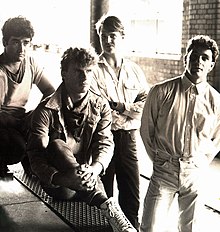Australian indie rock
This article needs additional citations for verification. (December 2012) |
Australian indie rock is part of the overall flow of
History
Beginnings
Isolated from the diversity of genres in the northern hemisphere, Australian mainstream record labels tried to replicate the success of trends imported from overseas and produce radio friendly singles by successful artists such as John Farnham and The Easybeats. In the meantime, Russell Morris enjoyed a surprise hit with singles such as "The Real Thing".[1] Produced by music legend Ian Molly Meldrum, and written by singing star Johnny Young, the single encompassed high production values and a psychedelic approach in its use of instruments such as a sitar, sampling of a children's choir, and its 6-minute running time (unusually long for the time). While released by EMI, this domestic production inspired a generation of bands, singers and songwriters that home-grown Aussie talent could produce world-beating music. The single charted well in New York, Houston and Chicago.[2]
Regional developments: 1970s to 1980s
Brisbane
The punk movement began in the mid-1970s, and resulted in an explosion of musical activity. Numerous bands formed, as did many independent record labels, often run out of bedrooms. An early band who gained a following in Australia were, The Saints, who grew out of Queensland and who recorded one of the first punk singles, releasing a single on vinyl before the Sex Pistols. Another important band who came out of Brisbane were the post-punk group, The Go-Betweens, who relocated to Britain in the early 1980s and were one of the most acclaimed bands of the decade.
Sydney
Sydney's Radio Birdman were heavily inspired by acts such as the MC5 and The Stooges, and the band defined the sound of the punk and post-punk movement in Sydney. The sound of both Midnight Oil and INXS were influenced by Radio Birdman, especially in their early albums. In 1970s Sydney, the Australian Federal Government's "youth station" Double J operated outside the mainstream radio stations and began playing various independent music from around the world. Double J (an AM station) eventually turned into Triple J (an FM station) in the early 1980s and began broadcasting nationally in 1989.
By the early 1980s Sydney had begun to eclipse the post-punk explosion of gloomy drug-addled Melbourne with its beach culture, summery pub music scene, and hubris.
Perth
A vibrant and interesting punk and post-punk scene also developed in Perth, Western Australia. Bands such as
Melbourne
Melbourne's post-punk scene was much more experimental than any of the other capital cities. The city spawned a lot of experimental and gothic rock, of which Nick Cave's band, the Boys Next Door (later to become the Birthday Party) was the most notable and influential.
Soon the raw energy of punk evolved into
This era can be said to have ended in the 1990s, when in the wake of the explosion of grunge, alternative music became mainstream. Major labels signed three-chord grunge/punk-style rock bands, commercial radio played them and the 'alternative' sound soon became ubiquitous, ultimately culminating in manufactured pop groups, styled to sound raucously 'alternative' and appearing on television commercials for mobile phones. In this way, this process of mainstreaming echoes what happened in the USA and UK.
Gold Coast

A small but active Indie Rock movement was evident on the Gold Coast in the late 1970s and early 80's. The Seven Ballerinas were an Australian Indie rock band from the Gold Coast, active from 1981 to 1984.[3] They are a significant contributor to the alternative rock music scene on the Gold Coast, Brisbane and Sydney, being one of the first bands from the Gold Coast to perform original material to audiences Australia wide.[4]
The Ballerinas was formed in 1981 on the Gold Coast from an amalgamation of two pre-existing new-wave bands, Ratpak and The Strand.[4] At the time, there was a mood for change on the Gold Coast music scene, as seen at the Macintosh Island concert, attended by around 2,000 people was headlined by The Strand, and also included Ratpak and several other local bands.[5] The Macintosh Island concert was a turning point in Gold Coast music. As noted at the time, it was a move away from disco, and towards a local sound that expressed the values and attitudes of Gold Coast youth.[5]
1990s to the present
The mainstreaming of alternative music did not kill
Several
See also
References
- ^ "Russell Morris - The Real Thing (1969)". Pop Archives. Archived from the original on Oct 30, 2023.
- ^ "Russell Morris". HowlSpace. Archived from the original on Apr 22, 2008.
- ISBN 0-86788-668-4.
- ^ a b Entertainment Section (1981). "It's plain ballet mad". Gold Coast Bulletin.
- ^ a b Dalton, Mike (September 1979). "Friday Focus: The bands of hope, Coast kids seek a lost chord and a new cause as they wax lyrical and satirical". Gold Coast Bulletin.
